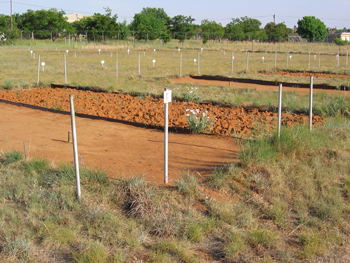Well-established root system important for sustainable production in semi-arid grasslands

Plot layout where production and root studies were done
Photo: Supplied |
The importance of a well-established root system for sustainable production in the semi-arid grasslands cannot be over-emphasised.
A study of Prof Hennie Snyman from the Department of Animal and Wildlife and Grassland Sciences at the University of the Free State is of the few studies in which soil-water instead of rainfall has been used to estimate above- and below-ground production of semi-arid grasslands. “In the past, plant ecological studies have concentrated largely on above-ground parts of the grassland ecosystem with less emphasis on root growth. This study is, therefore, one of the few done on root dynamics in drier areas,” said Prof Snyman.
The longevity of grass seeds in the soil seed bank is another aspect that is being investigated at present. This information could provide guidelines in grassland restoration.
“Understanding changes in the hydrological characteristics of grassland ecosystems with degradation is essential when making grassland management decisions in arid and semi-arid areas to ensure sustainable animal production. The impact of grassland degradation on productivity, root production, root/shoot ratios, and water-use efficiency has been quantified for the semi-arid grasslands over the last 35 years. Because of the great impact of sustainable management guidelines on land users, this study will be continuing for many years,” said Prof Snyman.
Water-use efficiency (WUE) is defined as the quantity of above- and/or below-ground plant produced over a given period of time per unit of water evapotranspired. Sampling is done from grassland artificially maintained in three different grassland conditions: good, moderate, and poor.
As much as 86, 89 and 94% of the roots for grasslands in good, moderate and poor conditions respectively occur at a depth of less than 300 mm. Root mass is strongly seasonal with the most active growth taking place during March and April. Root mass appears to be greater than above-ground production for these semi-arid areas, with an increase in roots in relation to above-ground production with grassland degradation. The mean monthly root/shoot ratios for grasslands in good, moderate, and poor conditions are 1.16, 1.11, and 1.37 respectively. Grassland degradation lowered above- and below-ground plant production significantly as well as water-use efficiency. The mean WUE (root production included) was 4.79, 3.54 and 2.47 kg ha -1 mm -1 for grasslands in good, moderate, and poor conditions respectively.
These water-use efficiency observations are among the few that also include root production in their calculations.